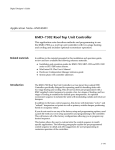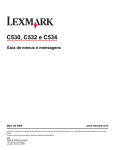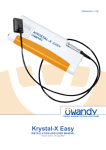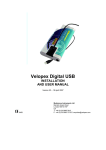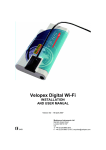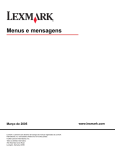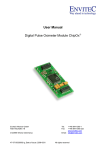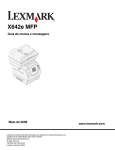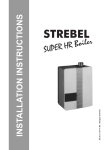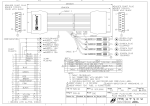Download HELiOS RESERVOIR REFERENCE GUIDE PREFACE
Transcript
HELiOS RESERVOIR REFERENCE GUIDE PREFACE This reference guide provides the information needed to unpack, set up, fill, and operate the Puritan Bennett HELiOS Reservoir. This information is intended for use by technicians or personnel qualified to set up and fill medical liquid oxygen equipment. Statements in this reference guide preceded by the following words are of special significance: WARNING ! Means there is the possibility of injury or death to yourself or others. ! CAUTION: Means there is the possibility of damage to the unit or other property, or situations causing reduced or no oxygen flow. NOTE: Provides important information about using the equipment properly. WARNING ! FIRE, FROSTBITE, AND HIGH PRESSURE HAZARDS. •Do not attempt to set up, fill, or operate the Reservoir until you read and understand the information in this reference guide. •Read the HELiOS Patient Operating Instructions (P/N B-701641-00) before operating the Reservoir. WARNING ! IMPROPER USAGE HAZARD. Oxygen supplied from this equipment is for supplemental use and is not intended to be life supporting or life sustaining. This equipment is not intended for use by patients who would suffer immediate, permanent, or serious health consequences as a result of an interruption in their oxygen supply. NOTE: The HELiOS Reservoir unit is intended only for the delivery of medical grade oxygen as prescribed by a physician. For product assistance contact: Mallinckrodt, Inc. 5647 Dividend Drive Indianapolis, IN 46241 Customer Service 1-800-635-5267 Technical Support 1-800-255-6774, press 2 Corporate Headquarters: Mallinckrodt, Inc. 675 McDonnell Blvd. P.O. Box 5840 St. Louis, MO 63134-5354 Telephone: 314-654-5345 Fax: 314-654-5345 Toll-Free: 1-800-635-5267 Information contained in this document, including performance specifications, is subject to change without notice. Mallinckrodt makes no warranty of any kind with regard to the material in this document, including, but not limited to, the implied warranties of salability and fitness for a particular purpose. Mallinckrodt shall not be liable for errors contained herein or for incidental or consequential damages in connection with either providing this document or the use of material in this document. B-701742-00 Rev. A HELiOS Reservoir Reference Guide Preface HELiOS RESERVOIR REFERENCE GUIDE 1.0 PRODUCT DESCRIPTION The HELiOS Reservoir (Figure 1) is part of an innovative liquid oxygen system that provides 24 hour per day home oxygen therapy with typically less than one liquid oxygen delivery per month. The Reservoir provides the patient with a source of liquid oxygen to fill any HELiOS Portable for ambulatory use and a source of gaseous oxygen to power the HELiOS 300 Portable at home. The unique design of the Reservoir virtually eliminates oxygen evaporative losses both in standby mode and when supplying gaseous oxygen to a patient. The Reservoir is available in two models that are nearly identical with the exception of the liquid oxygen storage capacity. The H-46 holds 110 pounds of liquid oxygen while the H-36 holds 85 pounds of liquid oxygen. Figure 1: HELiOS H-46 and H-36 Reservoir Units The Reservoir uses the popular Puritan Bennett top fill connector and is compatible with Puritan Bennett Companion® filling equipment (vent wrench, transfer hose assembly, source tank). The Reservoir requires a minimum 24 psig (166 kPa) saturated liquid oxygen to operate and may be filled using standard or fast fill techniques (Section 6.0). A standard integral pressure indicator on the unit helps the filling technician maintain proper liquid oxygen saturation pressure during the fill. An electronic contents indicator uses reliable, differential pressure based level sensing technology to provide accurate and easy to read liquid oxygen contents indication. The 9-volt battery powered contents indicator incorporates high visibility LEDs for indicating liquid oxygen contents. LEDs also warn of low battery and low contents conditions. B-701742-00 Rev. A HELiOS Reservoir Reference Guide - 1 The Reservoir provides 22 psig (152 kPa) gaseous oxygen at up to 10 L/min continuous flow through a Diameter Index Safety System (DISS) connection. Oxygen outlet pressure is regulated at 22 psig (152 kPa) since the unique design of the Reservoir allows internal pressure to climb as high as 45 psig (311 kPa). A flexible oxygen supply tube, attached to the outlet connector, provides gaseous oxygen to power the H-300 Portable. To fill the Portable with liquid oxygen, the patient merely engages the quick connect couplings on the Portable and Reservoir. The patient then opens the Portable vent valve to begin filling and closes the vent valve a short time later to terminate the fill. Reservoir pressure transfers slightly less than one pound of liquid oxygen into the H-300 Portable. Depressing a release button disengages the Portable from the Reservoir. Due to different operational specifications, Companion® System portables can not be filled from the HELiOS Reservoir. 2.0 PERFORMANCE SPECIFICATIONS The HELiOS Reservoir H-36 and H-46 performance specifications are listed below in Table 1. TABLE 1 HELiOS RESERVOIR SPECIFICATIONS MODEL H-36* H-46* Volume of Liquid Oxygen at 22 psig (152 kPa) Saturation (typical) 36 liters/1.27 ft3 46 liters/1.62 ft3 Weight of Liquid Oxygen (typical) 85 lbs/38.6 kg 110 lbs/49.9 kg Gaseous Oxygen Equivalent at 1atm. and 70°F 29,069 liters/1027 ft3 37,619 liters/1328 ft3 Height 33.5 in./85.1 cm 37.5 in./95.3 cm Diameter 15.4 in./39.1 cm 15.4 in./39.1 cm Empty Weight 50 lbs./22.7 kg 60 lbs/27.2 kg Full Weight 135 lbs/61.2 kg 170 lbs/77.1 kg * Specifications subject to change without notice. 2 - HELiOS Reservoir Reference Guide B-701742-00 Rev. A H ELiOS R ESER VOIR SPEC IFIC ATION S MOD EL H -36* H -46* Outlet Pressure 22 psi g/152 kPa Nomi nal (Acceptable Range 20.5-23.0 psi g/141-159 kPa) 22 psi g/152 kPa Nomi nal (Acceptable Range 20.5-23.0 psi g/141-159 kPa) Economiz er Pressure 27 psi g/186 kPa Nomi nal (Acceptable Range 24.0-30.0 psi g/166-207 kPa) 27 psi g/186 kPa Nomi nal (Acceptable Range 24.0-30.0 psi g/166-207 kPa) Primary R elief Valve Pressure 45 psi g/311 kPa Nomi nal (Acceptable Range 42-48 psi g/290-331 kPa) 45 psi g/311 kPa Nomi nal (Acceptable Range 42-48 psi g/290-331 kPa) Secondary R elief Valve Pressure 70 psi g/483 kPa Nomi nal (Acceptable Range 65-75 psi g/449-518 Pa) 70 psi g/483 kPa Nomi nal (Acceptable Range 65-75 psi g/449-518 Pa) N ormal Evaporation R ate (typical) (maximum) 1.2 lbs/0.54 kg per D ay 1.5 lbs/0.68 kg per D ay 1.2 lbs/0.54 kg per D ay 1.5 lbs/0.68 kg per D ay Fill Time (standard technique) (fast fill technique) Warm < 8 mi n./C old < 6 mi n. Warm < 4 mi n./C old < 3 mi n. Warm < 9 mi n./C old < 7 mi n. Warm < 5 mi n./C old < 4 mi n. Maximum Outlet Flow 10 L/mi n 10 L/mi n C ontents Indicator Electroni c, D i fferenti al Pressure Based w/Remote Indi cati on Opti on Electroni c, D i fferenti al Pressure Based w/Remote Indi cati on Opti on -20° C to 40° C 95% max. relati ve humi di ty -40° C to 70° C 90% max. relati ve humi di ty -20° C to 40° C 95% max. relati ve humi di ty -40° C to 70° C 90% max. relati ve humi di ty Environmental (Operating Temp.) (Storage Temp.) * Specifications subject to change without notice. B-701742-00 Rev. A HELiOS Reservoir Reference Guide - 3 3.0 UNPACKING, INSTALLATION, AND REPACKING Perform the following procedures when unpacking, installing or repacking a HELiOS Reservoir unit. 3.1 Unpacking 1. Examine the shipping carton for damage. If the carton is damaged, or its contents are suspected of being damaged, photograph the damaged carton before the Reservoir is unpacked. Contact the carrier to request a damage inspection. Contact the shipping point immediately. 2. Place the shipping carton on a flat surface with the shipping arrows pointing upwards. 3. Open the top flaps of the shipping carton and remove accessory items. 4. Remove the plastic bag covering the Reservoir and any loose packing inserts. 5. With the assistance of a helper, grasp a handle on the side of the Reservoir. Hold the carton down with one hand and carefully lift the Reservoir up and out of the carton. 6. Compare the packing list attached to the carton’s exterior with the shipment received. If any discrepancies exist, contact Mallinckrodt immediately at 1-800-497-4968. 7. Thoroughly inspect the exterior of the Reservoir for damage (dents, cracks, etc.). 8. Save all packing materials and the shipping carton for reuse. 3.2 Installation Before installing the Reservoir in a patient’s home, read and understand Section 4, Controls, Indicators, and Connectors; Section 5, Safety Precautions; Section 6, Filling Instructions; and Section 7, Operating Procedures. Perform the following steps upon receipt of shipment: 1. Remove the moisture container and record the Reservoir serial number. Reinstall the moisture container. 2. Verify the fill connector release button and mechanism move freely. 3. Press the button on the contents indicator. Verify that the yellow low contents LED lights. 4. Verify that a Reservoir vent wrench is available for filling the unit. 5. Verify receipt of the HELiOS Patient Operating Instructions. 4 - HELiOS Reservoir Reference Guide B-701742-00 Rev. A 3.3 Repacking for Return To return a product, contact Mallinckrodt at 1-800-255-6774 (press 2) and ask to speak with a Technical Support Representative. A Return Goods Authorization (RGA) number will be issued to track the product return. Please have available your account number, the model and serial number of the product, and the reason for returning the product when you call to request an RGA. Return the unit in its original carton, if possible. If the original carton is not available, you may purchase a new carton. WARNING ! 4.0 Fire hazard and extreme cold hazard. Do not package or ship units that contain liquid or gaseous oxygen. Liquid oxygen spillage and high oxygen concentrations are possible. Empty oxygen contents completely before packaging or shipping units. 1. Obtain the proper carton and inserts for the Reservoir you wish to package. 2. Make sure that the carton inserts are properly in place. 3. With the assistance of a helper, grasp a handle on the side of the Reservoir and carefully lift the Reservoir up and into the carton. Make sure the inserts snugly support the Reservoir. 4. Fold down the set of carton top flaps that press against the top of the Reservoir. Fold down the second set of flaps and insert the locking tabs into the first set of flaps. 5. Secure the carton with packing tape. CONTROLS, INDICATORS, AND CONNECTORS The controls, indicators, and connectors that are used on the Reservoir unit are shown in Figure 2. Their functions are described below. 4.1 Fill Connector The Reservoir uses the top fill Puritan Bennett fill connector to transfer liquid oxygen to and from the unit. It is the male half of a cryogenic quick connect coupling system. A spring loaded poppet automatically opens when the connector is engaged and automatically closes when the connector is disengaged. 4.2 Release Button Pressing the release button on the Reservoir activates the fill connector release lever mechanism. This disengages either a portable oxygen unit or a liquid oxygen transfer line from the Reservoir. B-701742-00 Rev. A HELiOS Reservoir Reference Guide - 5 4.3 Vent Valve The vent valve is a quarter-turn ball valve that is accessible with a separate vent wrench through a hole in the Reservoir top cover. The filling technician opens the vent valve to vent the inner container during the Reservoir unit filling process. The technician closes the valve upon terminating the filling process. 4.4 Pressure Indicator The pressure indicator displays the status of the pressure inside the Reservoir unit. A filling technician monitors the pressure indicator to help maintain a minimum 24 psig (166 kPa) liquid oxygen saturation pressure in the Reservoir during a fill. Under normal operating conditions, the indicator pointer typically indicates a pressure between 27 psig (186 kPa) and 45 psig (311 kPa). The pressure indicator does not indicate the regulated pressure at the Reservoir oxygen outlet. 4.5 Contents Indicator The contents indicator displays the amount of liquid oxygen in the Reservoir. Depressing the button on the contents indicator turns on from one to eight green light emitting diodes (LEDs) that represent the empty to full range of the Reservoir. A yellow “low contents” LED comes on when about 8.5 lbs. (3.9 kg) of liquid oxygen remain. A 9-volt battery powers the contents indicator. A low battery yellow LED comes on when battery voltage drops below a predetermined level. 4.6 Oxygen Outlet The Reservoir oxygen outlet provides a source of 22 psig (152 kPa) regulated oxygen at a maximum flow of 10 L/min. A spring activated poppet in the Diameter Index Safety System (DISS) oxygen connector stops oxygen flow when there is nothing attached to the connector. When a HELiOS Portable oxygen supply tube or a flow control device calibrated at 22 psig (152 kPa) is attached to the outlet, the connector poppet opens to allow oxygen to flow. 4.7 Moisture Container The moisture container is part of the Reservoir shroud assembly that collects condensed water run-off from the warming coils. The lower shroud channels the water run-off into the moisture container. The moisture container slides easily out of the lower shroud assembly to be emptied. 6 - HELiOS Reservoir Reference Guide B-701742-00 Rev. A Pressure Indicator Vent Valve Contents Indicator Fill Connector Oxygen Outlet Release Button Moisture Container FIGURE 2: Controls, Indicators, and Connectors 5.0 SAFETY PRECAUTIONS This section covers precautions and safe practices as they apply to facilities and personnel involved in servicing medical oxygen equipment. These precautions are divided into three main areas: cold safety, expansion safety, and fire safety. To ensure reliability and safety, the service techniques, work area, and equipment used in the storage, service, and handling of this system must be of the highest standard. Refer to the HELiOS Patient Operating Instructions (B-701641-00) for additional safety precautions regarding the use of this equipment. 5.1 Cold Safety WARNING ! Extreme cold hazard. Liquid oxygen (-297°F/-183°C) will freeze skin on contact. Never touch liquid oxygen or frosted parts. WARNING ! B-701742-00 Rev. A Extreme cold hazard. Liquid oxygen can spill if the Reservoir is tipped over. Keep the Reservoir upright at all times. HELiOS Reservoir Reference Guide - 7 WARNING ! Extreme cold hazard. Forceful discharge of liquid oxygen possible if fill connector freezes open upon disengagement. Always dry fill connectors with clean, dry, lint free cloth before fill. Recommended Protective Clothing: • Heavily insulated gloves (for example, cryogenic or welding gloves). Never use gloves that are contaminated with grease or oil when working with liquid oxygen. • Protective face shield. • Long sleeve shirt. Wear natural fibers such as cotton or wool. Avoid synthetic materials such as polyester or rayon. • Long pants. Never wear pants with cuffs. Liquid oxygen may become trapped and cause serious burns to skin. Wear natural fibers such as cotton or wool. Avoid synthetic materials such as polyester or rayon. • Protective cryogenic or welding apron. Important Facts: • Direct exposure to liquid oxygen or exposure to its vented gas or components cooled by liquid oxygen can result in frostbite. If frostbite occurs, seek medical attention immediately. 5.2 Expansion Safety W ! WARNING Explosive hazard. Extreme high pressure can rupture container or plumbing components. Be sure specified pressure relief devices are present and functioning properly. Important Facts: • Liquid oxygen at atmospheric pressure expands at a ratio of approximately 860:1 (at 0 psig) when vaporizing into a gas (Figure 3). This can occur very rapidly when exposed to the heat in the atmosphere. • Ensure that the specified pressure relief devices are present and functioning properly in any device that will contain liquid oxygen. This includes transfer hose assemblies. GAS LOX 1 860 Figure 3: Liquid Oxygen Expansion Ratio 8 - HELiOS Reservoir Reference Guide B-701742-00 Rev. A 5.3 Fire Safety WARNING ! Fire Hazard. Do not smoke. Death or injury may occur. WARNING ! Concentrated Oxygen. Increased risk of fire. Keep away from: • Sources of ignition (cigarettes, open flames, electrical equipment, etc.) • Sources of heat (furnaces, stoves, dryers, water heaters, etc.) • Flammable materials (asphalt, oil, grease, petroleum jelly, hand creams, aerosols, wood, etc.) • Store and service oxygen systems in well-ventilated areas. • If a liquid oxygen spill occurs indoors, open doors and windows to ventilate the area. Avoid sources of ignition and do not walk on or roll equipment over the affected area. • Any clothing or porous material that is splashed with liquid oxygen or otherwise absorbs high concentrations of oxygen should be removed and aired for at least one hour away from any source of ignition. Important Facts: The possibility of fire exists when the combination of a fuel, source of ignition, and oxygen is present (Figure 4). High concentrations of oxygen (air is approximately 21% oxygen) greatly enhance the possibility of combustion. • Keep liquid oxygen equipment at least five feet away from electrical equipment. • Obtain all replacement parts for medical oxygen equipment from the manufacturer. • Before servicing, clean all tools that come into contact with the oxygen system. • Use only recommended oxygen compatible cleaning and leak detection products. • Keep the Reservoir upright at all times. Secure liquid oxygen equipment when transporting to prevent accidental tipover and spillage. Figure 4: Combustion Triangle B-701742-00 Rev. A HELiOS Reservoir Reference Guide - 9 6.0 FILLING INSTRUCTIONS The Reservoir must be filled with liquid oxygen saturated at a minimum 24 psig (166 kPa) to ensure proper operation. The information in this section will help you fill the Reservoir with liquid oxygen in a proper, safe, and efficient manner. 6.1 Oxygen Source Requirements The HELiOS Reservoir must be filled with only U.S.P. Medical Oxygen. The liquid oxygen used for filling the Reservoir must have no moisture content. Liquid oxygen in the Reservoir must be saturated at a minimum 24 psig (166 kPa) for proper operation to occur. In order to achieve at least 24 psig (166 kPa) saturation in the Reservoir, the saturation pressure of the liquid oxygen filling source must be carefully considered. The filling source saturation pressure requirement mainly depends on the type of filling technique used. The Standard Fill technique requires a liquid oxygen source saturation pressure of 40-50 psig (276-345 kPa). The Fast Fill filling technique requires a liquid oxygen source saturation pressure of 24-28 psig (166-193 kPa). Following is a brief description of each filling technique and corresponding liquid oxygen source requirement. Both Reservoir filling techniques use pressure in the source tank as the force to drive the liquid oxygen into the Reservoir. In order to transfer liquid oxygen from the source tank to the Reservoir, a pressure differential must exist so that the source tank pressure remains greater than the Reservoir pressure during the fill. The Standard Fill technique requires the source saturation pressure to be greater than the saturation pressure needed in the Reservoir. With the filling source saturated at 40-50 psig (276-345 kPa), the boiling action of the liquid oxygen maintains the pressure differential as the Reservoir pressure is lowered by opening its vent valve. Monitoring the Reservoir pressure indicator while adjusting (throttling) the Reservoir vent valve enables the filling technician to maintain 24-28 psig (166-193 kPa) saturation pressure in the Reservoir during the fill. However, liquid oxygen saturated at 40-50 psig (276-345 kPa) is at a higher temperature than liquid oxygen saturated at 24-28 psig (166-193 kPa). During the fill, liquid oxygen saturated at 40-50 psig (276345 kPa) in the source tank boils rapidly to release heat and cool down to the lower temperature required for 24-28 psig (166-193 kPa) saturation in the Reservoir. The rapid boiling (desaturation) of the liquid oxygen creates a large volume of gaseous oxygen that is vented out the Reservoir vent valve during the fill. With the source saturated at 50 psig (345 kPa), about 8% of the liquid oxygen withdrawn from the source tank to fill the Reservoir boils off into gas and is expelled through the vent valve as a result of the depressurization (Figure 5). Consequently, slower fill times and greater filling losses occur with the Standard Fill technique. 10 - HELiOS Reservoir Reference Guide B-701742-00 Rev. A Figure 5: Vapor Release from Depressurized Liquid Oxygen The Fast Fill technique requires the liquid oxygen saturation pressure in the source tank to be about 24-28 psig (166-193 kPa), the same as the saturation pressure needed in the Reservoir. With the source saturated at 24-28 psig (166-193 kPa), rapid boiling (desaturation) of the liquid oxygen does not occur as it moves from the source tank into the Reservoir during a fill. However, in order to drive the liquid oxygen from the source tank to the Reservoir, a pressure differential must exist so that the source tank pressure remains greater than the Reservoir pressure during the fill. Consequently, a source tank equipped with a pressure building circuit must be used with the Fast Fill technique. By turning on the pressure building system in the source tank, a small amount of the liquid oxygen in the tank vaporizes in a heat exchanger and builds pressure above the surface of the liquid oxygen. This provides the head pressure (40-50 psig/276-345 kPa) needed to drive the liquid oxygen saturated at 24-28 psig (16-193 kPa) into the Reservoir. The filling technician maintains a minimum 24 psig (166 kPa) saturation in the Reservoir by monitoring the Reservoir pressure indicator and adjusting (throttling) the vent valve. Faster fill times and less filling losses are the end results. The Fast Fill technique requires a source tank that meets the following conditions: 1. The source tank must be filled with liquid oxygen saturated at 24-28 psig (166-193 kPa). 2. The source tank must be equipped with a 24-28 psig (166-193 kPa) road relief valve, a 40-50 psig (276-345 kPa) pressure building relief valve, and a means to switch between the two relief valves. The 24-28 psig (166-193 kPa) relief valve maintains source tank saturation pressure between fills. The 40-50 psig (276-345 kPa) relief valve enables pressure building to occur during a fill. 3. The source tank must have a pressure building system capable of maintaining 40-50 psig (276-345 kPa) head pressure during each fill. Since a variety of source tank configurations are available, contact Mallinckrodt Technical Support for advice when considering a liquid oxygen source and filling technique to best meet your needs. B-701742-00 Rev. A HELiOS Reservoir Reference Guide - 11 6.2 Transfer Line The standard Puritan Bennett transfer line assembly (Figure 6) is used to transfer liquid oxygen from the source tank to the Reservoir. The 5/8-in. flared connection on the transfer line source adaptor connects to a mating fitting in the source tank liquid withdrawal valve. WARNING ! Explosive hazard. Extreme high pressure can rupture a transfer line. Make sure a proper pressure relief valve is present and functional on the transfer line assembly. Source Adapter 150 PSI (1035 kPa) Relief Valve Puritan-Bennett Fill Adapter Transfer Hose Figure 6: Standard Transfer Line Assembly 6.3 Pre-Fill Inspection Perform the following procedure to visually inspect the Reservoir and determine its operational status before filling. Correct observed problems before proceeding to fill the Reservoir. 1. 2. 3. 4. 5. Ask the patient if there are any questions or concerns regarding the equipment since your last visit. Visually inspect the Reservoir unit for overall product integrity (for example, cracked or damaged components). Verify that all labels are present and legible on the unit (Figure 7). Verify that no frost or heavy condensation is present on the container below the shroud and that there is no excessive venting from the relief valve. (Some venting from the relief valve is normal.) Verify that the liquid oxygen contents level is consistent with the delivery schedule and expected patient usage. 12 - HELiOS Reservoir Reference Guide B-701742-00 Rev. A 6. 7. 8. Verify that the fill connector is not worn, leaking, or damaged. Verify that the vent valve stops are not bent or broken. Verify that the contents indicator is operational and at least one green LED lights when the button is depressed. The yellow low contents LED may light if the Reservoir is low or empty. Replace the 9-volt battery if the yellow low battery LED is on. 9. Verify that the pressure displayed on the Reservoir pressure indicator is 24-48 psig (166-331 kPa) if the unit contains liquid oxygen. 10. Verify that the moisture container is in place and empty. HELiOS ® OXYGEN REFRIGERATED LIQUID-USP UN1073 Oxygen Connector OXYGEN 2 701529 BY AIR LIQUEFACTION WARNING REV. A Do not exceed 10 L/min maximum flow. 701533 Rev. A CAUTION Wipe connector dry before filling HELiOS Reservoir 701528 Rev. A DO NOT SMOKE near this unit. Keep away from heat, flame or sparks. Keep unit well ventilated at all times. Do not touch frosted parts. Keep unit in upright position. Read Patient Operating Instructions. Puritan-Bennett Corporation Indianapolis, IN 46241 USA CAUTION: Federal (USA) law restricts this device to sale by or on the order of a physician. 701527 Rev. A Figure 7: Reservoir Labels 6.4 Filling Procedure Perform the following procedure to fill a HELiOS Reservoir with liquid oxygen. WARNING ! Fire hazard. Liquid oxygen spilled on asphalt or any other combustible surface will increase the possibility of fire if an ignition source is present. Always fill the unit on a non-combustible surface, such as concrete or a steel drip pan. WARNING ! B-701742-00 Rev. A Explosive hazard. Extreme high pressure can rupture a transfer line. Make sure a proper pressure relief valve is present and functional on the transfer line assembly. HELiOS Reservoir Reference Guide - 13 WARNING ! Fire hazard. Liquid oxygen spillage will occur if the Reservoir is tipped over. Before transporting, secure in an upright position Reservoir units that contain liquid oxygen . WARNING ! Fire hazard. Oxygen can accumulate in a delivery vehicle. Exhaust vent gases to outside of vehicle. (See CGA Safety Bulletin SB-9.) 1. Wear the proper protective clothing (Safety Precautions, Section 5). 2. Verify that the liquid oxygen saturation pressure in the source tank is 40-50 psig (276345 kPa) if using the Standard Fill technique. Verify that the liquid oxygen saturation pressure in the source tank is 24-28 psig (166-193 kPa) if using the Fast Fill technique. Refer to Section 6.1, Oxygen Source Requirements for more information on source tank requirements. NOTE: If you experience difficulty obtaining properly saturated oxygen, consult the Technical Service Department in Indianapolis for alternatives. 3. Attach the 5/8-in. female end of the transfer line source adapter to the liquid withdrawal valve of the source tank. Position the source adapter relief valve straight up. 4. If the Reservoir contains some liquid oxygen, verify that the Reservoir pressure gauge reads 24-48 psig (166-331 kPa). A pressure reading outside of this range may indicate a problem. If the unit is empty, continue with step 5 without verifying the pressure at this point. 5. Remove the fill connector cover from the fill connector, if present. (Available as an option). 6. Check the fill connectors on both the Reservoir unit and the fill adapter to ensure that they are clean and dry. Wipe the connectors with a clean, lint-free cloth or blow-dry with gaseous oxygen or nitrogen as needed. 7. Use the vent wrench to open the vent valve on the Reservoir unit by rotating the wrench a quarter-turn counterclockwise. NOTE: At this point you may hear a venting noise if the Reservoir unit is pressurized. 8. Engage the transfer line to the fill connector on the Reservoir unit by aligning the fill connector on the transfer line directly over the fill connector on the Reservoir. Apply about 20 lbs. of downward force. 9. Maintain a downward force on the transfer line fill adapter while slowly opening the liquid valve on the source tank. At this point a vigorous audible venting noise will confirm that the filling process has started. Adjust the source tank liquid valve as needed to keep the pointer on the Reservoir pressure indicator at 24-28 psig (166-193 kPa). 14 - HELiOS Reservoir Reference Guide B-701742-00 Rev. A NOTE: It may be necessary to open the source tank liquid valve completely and partially close the Reservoir vent valve to maintain the proper pressure throughout the fill. 10. Close and reopen the vent valve on the Reservoir after 45 to 60 seconds have passed. This will minimize the possibility of the vent valve freezing in the open position. NOTE: As the level of liquid oxygen nears the top of the Reservoir inner container, the sound and appearance of vapors escaping through the vent valve will change. The vapor will become denser, and as liquid oxygen reaches the vent valve, a discharge of liquid oxygen will be visible and audible. NOTE: The first observed discharge of liquid oxygen usually results from turbulence inside the container and does not necessarily indicate the unit is full. To ensure a complete fill, continue filling until you observe a steady stream of liquid oxygen. WARNING ! Extreme cold hazard. Liquid oxygen discharge from the fill connector can occur. When disconnecting the transfer line, never stand directly over the Reservoir fill connector. If the Reservoir fill connector stays open and minor liquid oxygen discharge occurs, carefully re-engage and disengage the transfer line to help dislodge any ice or other obstruction. If major liquid oxygen discharge (steady stream) occurs, open the vent valve (if safely possible) to vent pressure and stop the release of liquid oxygen. Open windows to ventilate the room and do not walk on areas exposed to liquid oxygen for 60 minutes after frost disappears. 11. When you notice a steady stream of liquid oxygen exiting the vent valve, disconnect the transfer line from the Reservoir by depressing the portable release button and lifting the fill adapter straight up. Close the vent valve immediately by rotating the vent wrench a quarter-turn clockwise. ! CAUTION: If the vent valve freezes in the open position, terminate the fill by disconnecting the transfer line and then allow the vent valve to warm until it closes easily. If the vent valve remains open for a period of time, the liquid oxygen in the unit will desaturate to a pressure lower than required. If this occurs, refer to Section 6.6, Checking Saturation Pressure. 12. Replace the fill connector cover, if present, on the Reservoir unit. Close the source tank liquid valve when the frost melts from the transfer line assembly. WARNING ! B-701742-00 Rev. A Extreme cold hazard. Liquid oxygen discharge from the transfer line relief valve can occur. Closing the source tank liquid valve before the frost on the transfer line melts may trap liquid oxygen in the transfer line. This may cause the relief valve to open forcefully. Never place hands, arms, or face directly over the relief valve. HELiOS Reservoir Reference Guide - 15 6.5 Post-Fill Inspection Perform the following procedure to inspect the Reservoir and determine its operational status after filling it with liquid oxygen. Correct observed problems before placing the unit in service. 1. Verify that the Reservoir fill connector poppet is closed and not leaking. 2. Verify that the vent valve is completely closed and not leaking. 3. Verify that the Reservoir pressure indicator reads at least 24 psig (166 kPa) within five minutes after terminating the fill. 4. Verify that there is no frost or heavy condensation on the container below the shroud. 5. Verify that all green LEDs light when the contents indicator button is depressed. 6.6 Checking Saturation Pressure Perform the procedure listed below as needed to determine the saturation pressure of the liquid oxygen in a Reservoir unit. The Reservoir pressure indicator reading may not always be a true indication of the liquid oxygen saturation pressure. 1. Note the pressure indicated by the Reservoir pressure indicator. 2. Momentarily open the vent valve on the Reservoir and observe the pressure indicator pointer as it drops. 3. Note the pressure value where the indicator pointer hovers (Figure 8) and then close the vent valve. This is the approximate saturation pressure of the Reservoir. Saturation pressure readings between 24 and 48 psig (166 and 331 kPa) are in the acceptable pressure range of the unit. Initial Pressure Indication False Head Pressure True Saturation Pressure Figure 8: Indicator Needle “Hovering” 16 - HELiOS Reservoir Reference Guide B-701742-00 Rev. A 6.7 Resaturating Liquid Oxygen If the HELiOS Reservoir looses its saturation pressure and you correct the cause of this condition without emptying the liquid oxygen contents, saturation pressure can be restored by simply allowing the unit to stand in normal room conditions for a specified amount of time. The entire volume of liquid will usually regain proper saturation within several days. If, however, this is not a reasonable option, perform the following procedure: 1. Attach the source adapter of the transfer line assembly to either the gas withdrawal circuit or vent circuit of the source tank. 2. Connect the transfer line fill adapter to the Reservoir unit fill connector and depress to engage the fill connectors. 3. Slowly open the vent valve or gas withdraw valve on the source tank and monitor the Reservoir pressure gauge. Open the source tank valve just enough to see a slow, steady rise in the pressure gauge pointer. Be sure to leave the Reservoir vent valve closed. 4. When the Reservoir pressure indicator pointer reaches 24-28 psig (166-193 kPa), close the source tank valve. 5. Recheck the saturation pressure as described in Section 6.6. Repeat the resaturation procedure, if necessary, until the liquid oxygen is saturated. NOTE: Be sure to reconnect the transfer line to the source tank liquid valve after completing this procedure. 7.0 OPERATING PROCEDURES The patient uses the HELiOS Reservoir in two different ways. First, the Reservoir provides the patient with a liquid oxygen filling source for the HELiOS Portable. Second, it provides gaseous oxygen for the patient to breathe through the H-300 Portable when at home. Procedures for filling the Portable from the Reservoir are found in the HELiOS Patient Operating Instructions. To operate the Reservoir as a source of gaseous oxygen to supply the H-300 Portable, perform the following steps: B-701742-00 Rev. A 1. Verify that there is adequate liquid oxygen in the Reservoir to meet patient breathing needs. 2. Verify that the Reservoir pressure indicator reads 24-48 psig (166-331 kPa). The pressure at the Reservoir outlet is regulated at 22 psig (152 kPa). 3. Connect one end of the flexible oxygen supply tube to the Portable oxygen supply tube quick connect. Use the tube end that has the male half of the quick connect attached (Figure 9). 4. Attach the opposite end of the flexible oxygen supply tube to the oxygen outlet fitting on the side of the Reservoir. Screw the nut and barbed fitting onto the oxygen outlet fitting until snug. HELiOS Reservoir Reference Guide - 17 5. Verify that the tube connections are leak tight. 6. Place one of the tubes from the dual-lumen oxygen cannula on the H-300 Portable oxygen outlet connector (upper connector). Place the other cannula tube on the sensor connector (lower connector). Adjust the cannula on the face to receive oxygen comfortably. 7. Set the H-300 Portable flow control knob to the prescribed oxygen flow setting. NOTE: For additional information, refer to the HELiOS Patient Operating Instructions. (a) (b) Figure 9: Flexible Oxygen Supply Tube Connections 18 - HELiOS Reservoir Reference Guide B-701742-00 Rev. A TECHNICAL BULLETIN HELiOS OXYGEN SYSTEM TECHNICAL SUPPORT INFORMATION Mallinckrodt wishes to ensure current and future customer satisfaction regarding the release of the new HELiOS Oxygen System. To meet this objective, it is important that we have an opportunity to carefully investigate any HELiOS performance and service issues that may arise. From January 2000 through June 2000 we request that any HELiOS Reservoir or Portable with a service related issue be returned to the Mallinckrodt Indianapolis Technical Service Center for evaluation and disposition. A technical service manual, service parts, and service training will be available to our customers following this evaluation period. Please contact the Technical Service Center in Indianapolis, IN at 1-800-255-6774 Press 2 if you have questions regarding HELiOS service and to determine if the product must be returned for evaluation. The attached HELiOS Reservoir Reference Guide will assist you with the set up, filling, and operation of the HELiOS Reservoir. Similar information regarding the HELiOS H-300 Portable is available in the HELiOS Patient Operating Instructions (P/N B-701641-00) that is supplied with each unit. 01/19/00 B-701742-00 Rev. A




















